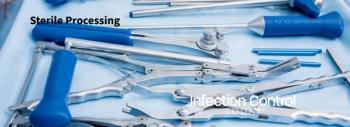
Performing Rigid Container Testing
By Nancy Chobin, RN, AAS, ACSP, CSPM, CFER
Q: We were recently cited for not performing rigid container testing. We have not heard of this test. Can you advise what this is and why this is needed?
A: The Association for the Advancement of Medical Instrumentation (AAMI) recommends that rigid containers (including those used for immediate-use steam sterilization) be biologically tested before purchase and periodically to verify that the sterilizer is able to sterilize inside the containers (ANSI/AAMI ST79). Conventional process challenge devices or test packs (PCDs) are based on textile test packs, not rigid containers, hence the recommendation to test rigid containers periodically. According to ANSI/AAMI ST79, “the sterilant enters through discrete portals in a container system. The sterilant must then work its way throughout the inside of the container system and then to the items being sterilized.
Two barriers need to be overcome before the inside of the container system reaches equilibrium with the sterilizer chamber.” Therefore, rigid containers are very different from regular wrapping material, where the entire surface is permeable to the sterilant.
“Rigid sterilization container systems vary widely in design, mechanics and materials of construction. Work practices, sterilizer performance characteristics, and the function of the healthcare facility utilities supplying the sterilizer can also affect the dynamics of the sterilization process. These factors can markedly affect the specific performance characteristics of rigid sterilization container systems and their suitability for particular sterilization methods and cycles.” Healthcare personnel bear the ultimate responsibility for ensuring that any packaging method or material, including a rigid sterilization container system, is suitable for use in sterilization processing and sterility maintenance.” (ANSI/AAMI ST79)
Another reason why AAMI recommends rigid container testing in healthcare facilities is that the manufacturers of container systems can only test their products in specific sterilization equipment. Sterilizers having the same sterilization cycle parameters could vary in size and in air removal efficiency. Manufacturers cannot possibly test all combinations of sterilizer sizes, cycles and process efficiencies. Therefore, users need to perform testing to identify any technical problems that must be resolved in consultation with the container system manufacturer, the sterilizer manufacturer and consultants. (ANSI/AAMI ST79)
Pre-purchase testing (testing before the containers are purchased) is recommended to ensure that the conditions essential to sterilization can be achieved and that the specific configuration of the container contents is compatible with the sterilization process and the requirements at the point of use. (ANSI/AAMI ST79)
In each rigid sterilization container system to be tested, BIs and CIs should be placed strategically alongside each other at locations that present the greatest challenge to air evacuation and sterilant penetration. Consult with the rigid container manufacturer regarding their recommended procedure for testing. Containers of each size to be used or being used should be tested, as well as a representative sample of each type of sterilizer. Testing consists of maximum-load testing and small-load testing. For example, if there are three 48-inch steam sterilizers in the department, the maximum-load tests can be performed in any one of the three sterilizers.
However, if the department has three different types, brands, or sizes of sterilizers, they should all be tested with containers. Furthermore, if the facility is using containers from more than one vendor, each vendor’s containers should be tested as described. Container testing does not replace routine biological monitoring with a BI PCD.
Test Container: Biological indicators and Type 4, Type 5, or Type 6 CIs should be placed in the areas that create the greatest challenge to steam penetration and air removal. Because these locations vary from one manufacturer to another, the manufacturer of the rigid sterilization container should be consulted regarding the placement of BIs and CIs. If the container manufacturer recommends that the BI be suspended from the underside of the container lid, the BI manufacturer should be consulted for guidance on how to perform this testing and on where to place the BI (e.g., adjacent to the filter). In gravity-displacement steam sterilizers, the corners of the container system and the underside of the lid, away from the filters, are the likeliest locations for air pockets.
Rigid containers have three dimensions: height, length, and width. If any one of these dimensions is different, it is considered a different size of container. The test container systems should represent the sizes that are being considered for purchase or are already being used for routine processing.
Unless otherwise directed by the container manufacturer, five BI vials should be assembled for placement inside each test container. An additional BI vial will be needed to act as a control. The five test BI vials and the control BI vial should be from the same lot.
Unless otherwise directed by the container manufacturer:
• Assemble the largest instrument set (including any optional absorbent material) recommended by the container system manufacturer.
• Place four of the test BI vials in the test container. Place one BI vial in each corner of the inside basket. Keep the vials in place0, attaching the string to the corner of the basket with sterilization tape.
• Attach the fifth BI vial under the lid. The BI should suspend into the container when the lid is closed. Check with the container manufacturer for where exactly to place the BI vial on the lid, according to whether the test is being conducted in a gravity-displacement or dynamic-air-removal cycle.
The date, sterilizer number, cycle number and an identification location number should be written on the BI vials and, if possible, on the back of the CIs. The purpose of the identification location number is to identify the positions of any positive BIs or failed CIs. A photograph of the placement and location identification will assist with troubleshooting. The container is then closed and locked. Each test container should be labeled as such, so that it will not be inadvertently distributed.
Recommended Testing: A maximum-load test and a small-load test should be run for representative sterilizers. For the remaining sterilizers, only the small-load test needs to be run.
Note that rigid container testing is also performed for containers intended for use in EO sterilization. In this case, only the maximum-load test need be performed. Small-load testing is not required because the maximum-load test represents the greatest challenge to EO sterilization cycles.
Maximum-Load Testing: The maximum-load test assesses the sterilizer’s ability to sterilize under actual use conditions. For this test, the user places two test container systems on the bottom shelf over the drain and two test container systems on each of the other sterilizer shelves (if space permits). For example, if the sterilizer cart has three shelves, a total of six test containers will be needed. The chamber is otherwise fully loaded with conventionally packaged items.
Small-Load Testing: The small-load test assesses a steam sterilizer’s ability to sterilize under worst-case conditions. One test container (prepared as described above) should be placed on the sterilizer cart shelf over the drain line. No additional test containers or other items should be placed in the sterilizer chamber. A sterilization cycle is run with the exposure time recommended by the container system manufacturer.
Test Results: When the sterilization cycle is completed, the test containers are removed from the sterilizer and the BI vials from the test containers. The container should be inspected for any signs of moisture on the instruments, on the optional absorbent material, or inside the container itself; any signs of moisture should be documented. After the BI vials are cooled they are incubated. All BI results must be negative, and all CIs must show a pass result. The results should be recorded as “container test pack testing” and identified as either maximum-load or small-load. In the maximum-load test, positive BIs or failed or inconclusive CIs suggest that the sterilization process was not adequate. If the small-load test fails, failures indicate insufficient steam penetration and/or insufficient air removal, which could be caused by the sterilizer, the container system, or the sterilizerâcontainer combination.
In the event of any positive BI results, failed/inconclusive CI results or moisture, a complete investigation into the cause is required.
Your department should have a policy and procedure for rigid container testing including the frequently of testing. AAMI recommends pre-purchase and periodic testing. Staff should be in-serviced in this process with competencies verified.
In summary, rigid container testing is an important part of your overall quality assurance testing. Since this testing is recommended by AAMI, it should be performed and documented. Staff should be familiar with this process and know how to perform and document the testing.
Nancy Chobin, RN, AAS, ACSP, CSPM, CFER, is a sterile processing consultant and educator.
References:
ANSI/AAMI: ST79:2017. “Comprehensive Guide to Steam Sterilization and Sterility Assurance in Healthcare Facilities.”
Basics of Sterile Processing 6th Edition. Sterile Processing University, LLC. Lebanon, N.J.
Newsletter
Stay prepared and protected with Infection Control Today's newsletter, delivering essential updates, best practices, and expert insights for infection preventionists.






